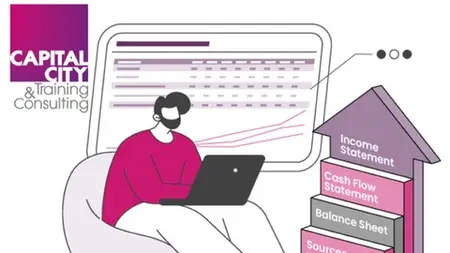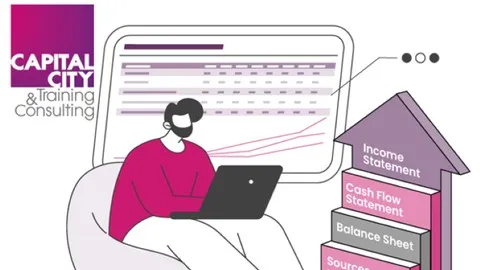Financial Modelling From Scratch
Published 11/2024
MP4 | Video: h264, 1920x1080 | Audio: AAC, 44.1 KHz
Language: English | Size: 10.19 GB | Duration: 8h 42m
Published 11/2024
MP4 | Video: h264, 1920x1080 | Audio: AAC, 44.1 KHz
Language: English | Size: 10.19 GB | Duration: 8h 42m
Learn to build an integrated 3-statement model in Excel with best-practice techniques. With fully downloadable models.
What you'll learn
Understand the essentials of financial model construction and design principles
Use real company data to build flexible time frameworks, forecast operations, and integrate historical data
Forecast working capital from an analyst perspective, with full integration to the financial statements
Learn and apply modelling of depreciation, debt structuring, interest expenses, and tax
Learn and apply key analysis techniques like DuPont Analysis and Discounted Cash Flow
Apply Excel tools, functions and tricks to enable building of a robust, flexible and scaleable fully integrated 3-statement financial model
Use Excel tools and structure to perform quick sensitivity analysis, scenario modelling with switches, credit, and liquidity analysis
Requirements
Some fundamental experience of using Excel - such as using $, Named Ranges, IF and SUM - but even these aspects will be illustrated and explained by the tutor during the course.
You will want some understanding of the construction of financial statements and how they are interlinked (eg earnings linked to Equity, EBIT reconciled to Operating Cash Flows.
If you need some pre-learning to cover the above, look for our Excel Skills for Modelling course and our Accounting and Analysis course, all on Udemy.
Description
Our comprehensive Best Practice Financial Modelling certification program teaches the essential skills needed to build robust forecast models for companies, and prepare you for careers in investment banking, private equity, corporate finance, and business valuation.Essentials of financial model construction and design principlesFlexible time frameworks, forecasting operations, and linking historical dataWorking capital modelling from an analyst perspectiveDepreciation, debt structuring, interest expenses, and tax modellingKey analysis techniques like DuPont Analysis and Discounted Cash FlowSensitivity analysis, scenario modelling, credit, and liquidity analysisCertificate Upon Successful CompletionThis course is designed for delegates familiar with the basic functionality of Excel. We will help them develop higher level Excel, design and modelling skills sufficient to allow them to build and sensitise integrated, company forecasting models suitable for credit analysis, debt sustainability analysis, capital budgeting and company valuation. As well as the techniques and challenges involved in this particular modelling application, delegates will also learn solid best practice in the construction of any time series forecasting in Excel.Delegates will progressively build an integrated balance sheet, profit and loss, and cash flow forecasting model, suitable for financial analysis, company valuation, debt structuring and capital structure optimisation.The training will develop Excel skills to allow delegates to develop rigorous financial models and be in a position to get the most out of the peer/third party models. A number of key skills will be addressed such as scenario management techniques; switches and text strings to make models clear and flexible; and data validation to control inputs.Specifically, delegates will:Improve their speed and fluency in Excel when modellingUnderstand design principles, time series best practices and how to “build in balance”Understand and be able to use Excel’s basic logical formulae and also a range of lookup and referencing formulae for scenario management;be able to use a range of basic cash flow valuation techniques and functions in Excel and know their shortcomings Have a clear method for building reliable, robust and flexible modelsBe able to build and troubleshoot their own and third-party modelsBe efficient in spotting inconsistencies when auditing other people’s financial modelsHave a set of tools for analysing and sensitising financial models.
Overview
Section 1: Introduction to building a model from scratch
Lecture 1 Introduction to building a model from scratch
Lecture 2 Intro to Modular Design
Lecture 3 Modelling Golden Rules
Section 2: Extracting data from PDFs and Recasting the Accounts
Lecture 4 Data extraction from a PDF into Excel
Lecture 5 Recasting exercise - debrief with SUMIF and Data Validation
Section 3: Model Set-up
Lecture 6 Model Set-up - Part 1
Lecture 7 Model Set-up - Part 2 formatting the easy way
Lecture 8 Model Set-up - Part 3 - Setting the timeframe and DATE functions
Lecture 9 Model set-up - Part 4 - consistent sheet headers, the quick way!
Lecture 10 Linking the Historic Data - Part 1 - reconciling historic P&L
Lecture 11 Linking the Historic Data - Part 2 - historic Cash Flow and Balancing the BS
Section 4: Beginning the Forecasts - Sales and EBITDA
Lecture 12 Sales and EBITDA Forecast methodology
Lecture 13 Forecast calculations - with a flexible trending formula
Lecture 14 Cross-linking Sales and EBITDA through the model
Lecture 15 Building in Balance - using the balance sheet as your safety net
Section 5: Working Capital Modelling and Building a Balance Sheet check
Lecture 16 Working Capital - what it is, from an analyst's perspective
Lecture 17 Modelling working capital - you have a go
Lecture 18 Modelling working capital - walk through with tutor
Lecture 19 Building a Balance Sheet check
Section 6: Fixed Assets, Debt, Other assets and Tax
Lecture 20 Modelling Fixed Assets, including depreciation and capex
Lecture 21 Modelling Debt
Lecture 22 Interest cost on debt
Lecture 23 Interest income
Lecture 24 JVs and Other Assets
Lecture 25 Tax expense
Lecture 26 Deferred Tax
Lecture 27 Tax - part 2: linking it into the financials
Section 7: Ratios - Dupont Analysis
Lecture 28 Dupont Analysis - what is it?
Lecture 29 Dupont - calculation in the model
Lecture 30 Dupont - the disaggregation of ROCE
Section 8: Divis and Discounted Cash Flow
Lecture 31 Modelling Dividends
Lecture 32 Determining the WACC for a DCF
Lecture 33 Doing the EV DCF modelling
Lecture 34 Equity Value adjustments and Share Price determination
Section 9: Refining the model
Lecture 35 Margin Sensitivity
Lecture 36 Refining Capex based on ROCE observations
Lecture 37 Sensitivity Analysis with Excel's Data Tables
Section 10: Credit and Liquidity
Lecture 38 Unilever's liquidity
Any finance professional involved in using or building financial models. Even if you don't have to build models, working through this course will give you the ability to review with more insight and understanding of models you see, and how to spot inconsistencies and errors.



